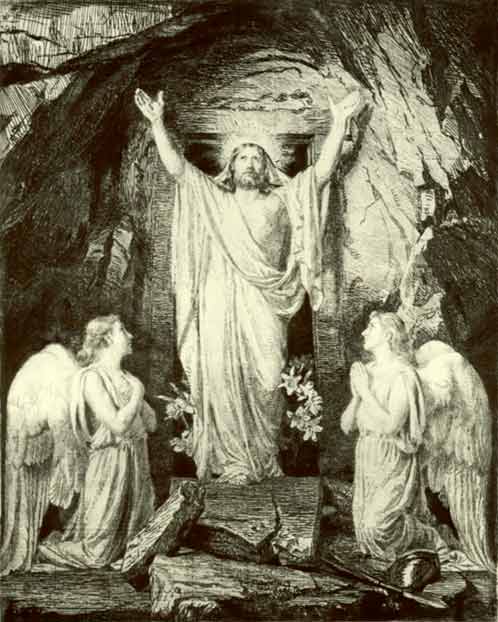Random Distribution
Supposing one finds a crypt in St. Louis, Missouri with the bodies of 'Seymour,' 'Lois,' and 'Joey.' Counting the
incidence of these names in the St. Louis phone book gives the likelihood of finding any one of them, from which the statistician
computes the likelihood of finding all three names together. Thus, if there is a family known from tax records whose members
included 'Seymour' and 'Lois,' though 'Joey' is unknown, one can give odds that this is their crypt. Though the 'phone book'
for first century Judaea is missing, and indeed as yet uninvented, some of the data it might have contained can
be reconstructed. . .or guessed at, anyway. According to the film-makers,
the odds are at least 600 to one that this crypt contains Jesus and His
family members. . .including His 'wife' Mary Magdalene, though no historical
source, gnostic or orthodox, so describes her.
It's interesting to reflect that name clusters, once formed, may replicate. Realizing that 'Seymour's' brother is more
likely to name his child 'Seymour' adds a wrinkle. 'Seymour' and 'Lois' could be first cousins
of the next generation. Names are not randomly distributed but recycled
through families. They were in that day also; what New Testament reader
has not wished only one person had been called 'Herod.' The reader of Roman
history likewise wishes there were only one Germanicus or Agrippa rather
than several confusingly so named. In fact children are likely to be named
after family members, so the same names recur down through historical narratives.
Likewise, whatever the incidence of the names 'Mohammed' and 'Fatima' during
the lifetime of Mohammed ibn Abdallah, the incidence of these names has
shot up dramatically till the present day, when they are very common names
indeed. This ever-increasing popularity is not in spite of, but because
of the founder's success in establishing a religion. One cannot know whether
the name 'Yeshua' was taken out of circulation amongst Christians once
Yeshua the Messiah ascended into heaven. Certainly today English-speakers
would dislike calling a little boy named 'Jesus' by his given name, though
they will call a Hispanic baseball player by that name provided he does
not anglicize the pronunciation. While one might expect this reluctance
to follow from opinions on the deity of Jesus Christ, in fact the parents
who named the ball-player 'Jesus' are likely to have believed that Jesus
Christ is God, and at no time did American Unitarians (back in the days
before they were more likely to be Wiccans) ever name their sons 'Jesus.'
Lenny Bruce used to wonder, 'If Jesus is Jewish, why does he have a Puerto
Rican name?' One cannot now know if His name, like Mohammed's name, became
more popular after His earthly ministry, or less so. Can the film-makers be playing off the sensationalistic assumption
that His name is unique?
The location of Mohammed's tomb is very well known, and indeed there is
a magnificent establishment on the site. Should everyone in the world happen
to forget where it's located, the strategy of finding it by searching for
name clusters would not lead to it. Not that plentiful clusters of 'Mohammed's'
and 'Fatima's' and 'Ali's' cannot be found; they can be found in abundance.
But these people aren't them; they are named after them.
At present, if you walk into a Catholic parochial school and call out 'Mary!,' so many little heads swivel your way
that you had best add a second name to distinguish a unique little girl. Was this common woman's name already increasing in popularity
in the early days of the church? One expects in the present day to find 'clusters' of such names: if Dad's name is 'Mohammed,' his
daughter's name is more, not less, likely to be 'Fatima.' If sister's name is 'Mary,' brother's name is more,
not less, likely to be 'Joseph.' 'Mary' [Maria, Mariam, Mariamne] was already a popular name in the world to which the gospel went out,
to judge from the New Testament, where we learn of Mary's sister Mary (John
19:25). Reportedly, one fourth of all the women in Jerusalem were so named.
Why was this name so popular in the day? Were these 'Marys' named after
Mariamne, the Hasmonean princess so shamefully treated by Herod? If so,
the fuss about various transliterations seems to be much ado about nothing.
Indeed, all the names listed in this burial chamber were common ones; 'Jesus' was not uniquely so named. Acts 13:6 mentions
a Cypriot who was the son of 'Jesus:' "When they had gone through the whole island as far as Paphos, they met a certain magician,
a Jewish false prophet, named Bar-Jesus." Josephus mentions quite a few men with that name; a random example: ". . .on which
king Agrippa took the high priesthood from him, when he had ruled but three months, and made Jesus, the son of Damneus, high
priest." (Josephus, Antiquities of the Jews, Book XX, Chapter IX 1.). The 'Jesus' of Acts 7:45 in the KJV is Joshua of the Old
Testament: "Which also our fathers that came after brought in with Jesus into the possession of the Gentiles, whom God
drave out before the face of our fathers, unto the days of David. . ." The name occurs not uncommonly
in the Septuagint, the Greek translation of the Old Testament, for instance
in Zechariah 6:11: "And thou shalt take silver and gold, and make
crowns, and thou shalt put them upon the head of Jesus ['Iesou'] the son of Josedec the high priest;. . ."
(Brenton Septuagint).
Given this name's occurrence in the Septuagint, it is unclear what the
authors have in mind when they say, "What many people don't realize
is that there is no Hebrew equivalent for 'Jesus.'" (The Jesus Family
Tomb, Simcha Jacobovici and Charles Pellegrino, p. 34). The English 'Jesus,'
after all, is a simple transliteration of the Greek 'Iesous.' Did this
name become more popular, within the family and within the world, after Jesus of Nazareth's earthly
ministry, or did it fall out of use altogether?
The bishop list given above shows that Jesus' family recycled names. This
family dominated the bishop's office at Jerusalem until the Bar Kochba
revolt after which Gentile bishops began their sway. Jesus had four brothers:
"Is this not the carpenter, the Son of Mary, and brother of James,
Joses, Judas, and Simon? And are not His sisters here with us?" (Mark
6:2). The obvious identification of these siblings is that they were children
of Joseph and Mary delivered after Jesus, "her firstborn" (Matthew
1:25, Luke 2:7), though this is resisted by some. Eusebius mentions grandchildren
of this Judas, Jesus' half-brother (both were biological sons of Mary,
only Judas of Joseph) in Chapter XX of Book III of his Ecclesiastical History.
After escaping interrogation by Domitian, Eusebius says, "Thus delivered,
they ruled the churches, both as witnesses and relatives of the Lord."
Just as with Seymour's brother's children in St. Louis, it is more likely, not less likely, that familiar family
names will recur amongst this group. Families with illustrious members are more, not less, likely to recycle names.
Inasmuch as most first century Palestinians lived and died without earning
a mention in either Josephus or the New Testament, the modern observer
who seeks to match grave inscriptions to known persons has assigned himself
no small task. In principle the methodology holds promise: the more names
that can be linked together, the more the possibilities are narrowed down.
We all do follow an informal algorithm like this when, on meeting someone
from the old neighborhood, school, or work-place, we verify common acquaintances
by accumulating attributes. While it is quite possible for two people to
share the same name, it is not likely that both of them would weigh 300
pounds, have a sister named Cybele, or enjoy watching figure-skating.
Suppose a society in which all men are named 'Tom,' 'Dick' or 'Harry.'
Suppose further these names are randomly distributed. Once you start linking:
say by employing the popular naming strategy, 'Tom the son of Dick,' you
have eliminated two-thirds of the 'Tom's.' This naming strategy is popular
because its logic is sound. If you can add, 'brother of Harry,' 'husband
of Susie,' 'father of Tom, Jr.,' you are focusing in further on a unique
individual. But not even that much is available here. 'Tom who has some
connection to Dick' adds little or nothing, because every 'Dick' has some 'Tom' in the family tree
somewhere. The known fact that names are not assigned randomly, but are recycled by families and by religious communities,
renders this entire enterprise even more suspect.
The film-makers are aware that families recycle names, and try to make
this principle work for them in morphing 'Matthew' from Mary's grand-father
into a first cousin. But this principle does not work for them, it works
against them. Jesus had four brothers and two sisters. Any one of these
people could have reconstituted a 'cluster' of family names in their own
brood of offspring, because siblings often do this. Jesus moreover had
a world of followers, any one of whom might have done the same.

|




